我们上期提到了二叉搜索树,只是简单的讲了一下原理,那么今天我们就讲一下AVL树。
目录
- AVL树的概念
- AVL树的实现
- AVL树的架构
- insert插入
- 引用pair对象
- 引进parent指针
- 仅插入数据
- 调节平衡因子
- 情况1:插入在父亲的右边,父亲的平衡因子++后为0
- 情况2:插入在父亲的左边,父亲的平衡因子--后为0
- 情况3:插入左或者右,恰巧父亲不是0,是-1/1
- 情况4:当父亲的平衡因子==-2/2,不需要在更新了,证明不平衡了,需要旋转。
- 左边高,右旋
- 右边高,左旋
- 双旋转
- 右左旋转:先右旋然后左旋。
- 左右双旋:先左旋,在右旋。
- 中序遍历
- 判断是否平衡
- AVL树整体代码
AVL树的概念
其实大家应该很奇怪,难道二叉搜索树不能存储数据吗?为什么要有AVL树呢?二叉搜索树有可能会有畸形的情况。像下图,数据比较分散的话,这棵树很正常,如果我们插入的数相对有序就会变成右边那样畸形的树。
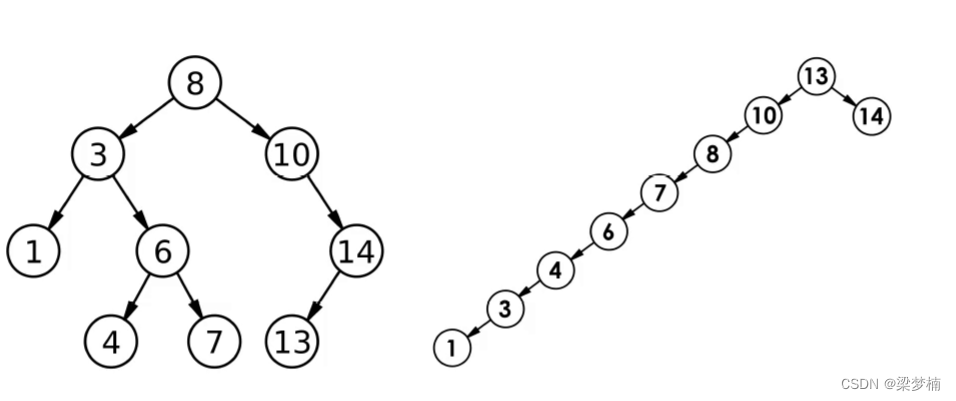
这个时候就需要人工干预,这里的AVL数就可以更好的控制这个情况,它有自己的平衡规则:左右子树高度之差(平衡因子)绝对不超过1(-1,0,1)。如果不满足这个规则,那么我们就旋转。
AVL树的实现
因为AVL树也是二叉搜索树的一种,所以他也要满足二叉搜索树的条件,然后在满足他自己的平衡规则。
AVL树的架构
其实数的节点架构和整体架构并没有变,只是多了一个bf(平衡因子),用来调节平衡。
struct AVLTreeNode
{AVLTreeNode(const pair<K, V> kv):_left(nullptr),_right(nullptr),_parent(nullptr),_kv(kv),_bf(0){}AVLTreeNode* _left;AVLTreeNode* _right;AVLTreeNode* _parent;pair<K, V> _kv;int _bf;
};
template<class K,class V>
class AVLTree
{public:typedef AVLTreeNode<K,V> Node;private:Node* _root=nullptr;
}
insert插入
引用pair对象
这里与原来不同,这里我们引入了一个pair对象,那么pair是什么?我们用pair来实现KV结构,在库中的map也是用pair也完成KV结构的,所以这里我们就用这pair。pair对象的first是K值,second是V值。
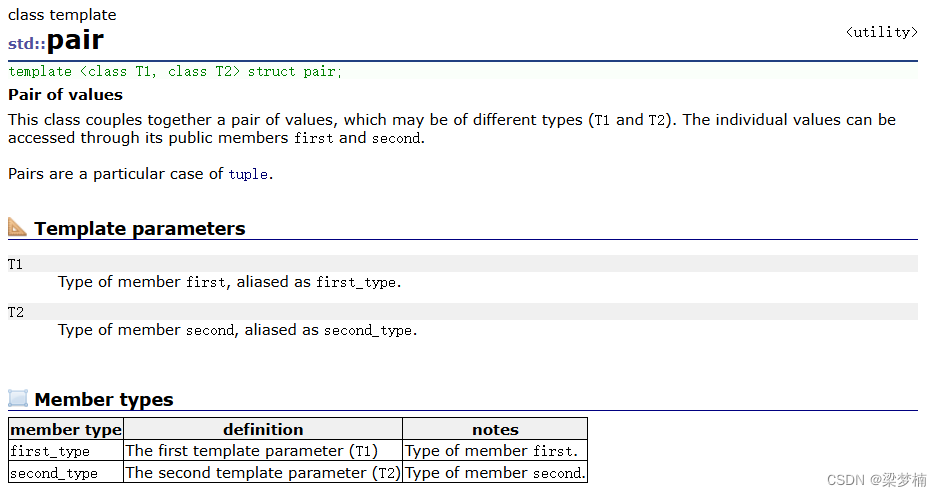
引进parent指针
这里引用父指针是因为我们将来要旋转,要不断向上调节平衡因子,因为当我们插入某个值有可能引起平衡因子失衡。
仅插入数据
其实插入部分和我们之前写的一样,只不过要注意的是,我们的值存的是pair对象,要像拿到K值需要 _kv.first拿到K值。一定要遵循二叉搜索树的规律,左子树比根小,右子树比根大。
if (_root == nullptr){//插入第一个值Node* newNode = new Node(kv);_root = newNode;return true;}Node* newNode = new Node(kv);Node* cur = _root;Node* parent = cur;while (cur){if (cur->_kv.first < newNode->_kv.first){//大于在右边parent = cur;cur = cur->_right;}else if (cur->_kv.first > newNode->_kv.first){//小于在左边parent = cur;cur = cur->_left;}else{//等于,二叉搜索树不允许冗余,所以直接返回false。return false;}}if (parent->_kv.first > newNode->_kv.first){//在左边parent->_left = newNode;}else{//在右边parent->_right = newNode;}newNode->_parent = parent;
调节平衡因子
情况1:插入在父亲的右边,父亲的平衡因子++后为0
红色是我插入的数,插入后,它的parent:12从-1加加后变成了0,我们还需要向上更新吗?答案是不需要向上更新,为什么?0表示左右子树的高度差为0,也就说高度没有变,所以我不需要再向上更新。
解释:平衡因子原来是1/-1都表示这个树缺了一个节点,当我们插入之后正好填上了这个节点,但是高度并不变。看图!我把15插入,右子树这个高度没有变。
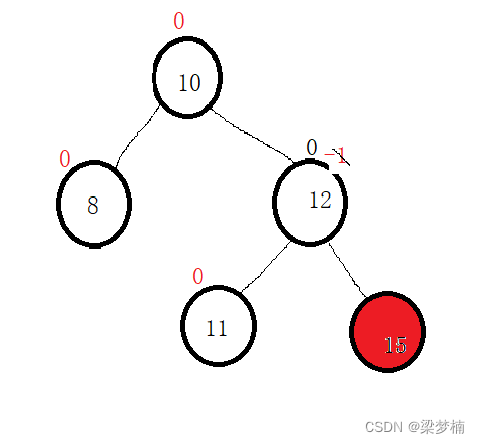
情况2:插入在父亲的左边,父亲的平衡因子–后为0
当我插入在左边,那我们就需要给父亲的因子bf–。
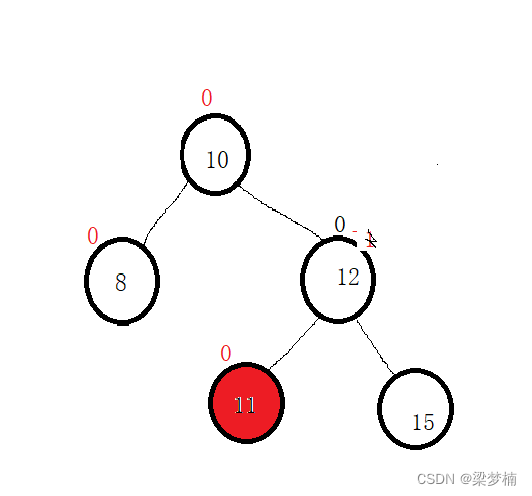
情况3:插入左或者右,恰巧父亲不是0,是-1/1
父亲的平衡因子==1/-1,父亲所在子树高度变了。高度变了继续向上更新。
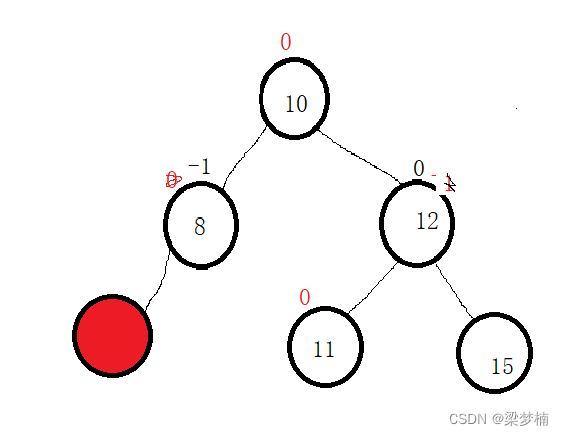
情况4:当父亲的平衡因子==-2/2,不需要在更新了,证明不平衡了,需要旋转。
这个时候就不满足AVL树的规则了,就需要旋转。
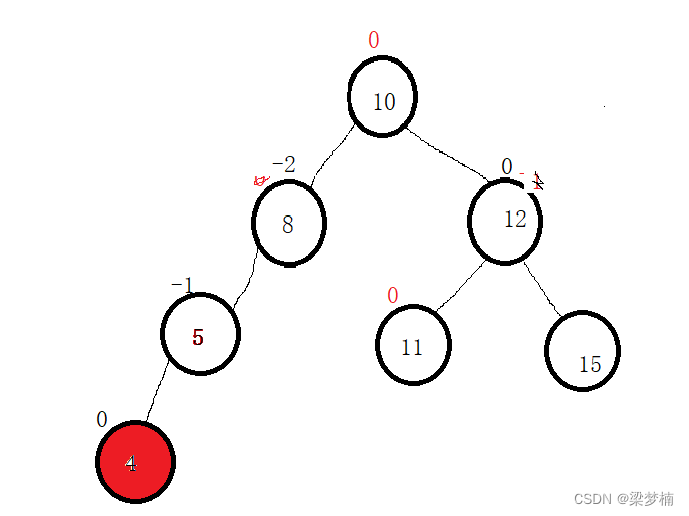
左边高,右旋
这个树就是左边高的情况,你会发现parent为-2,cur为-1,这个情况就是左边比右边要高,那么我们需要右旋。
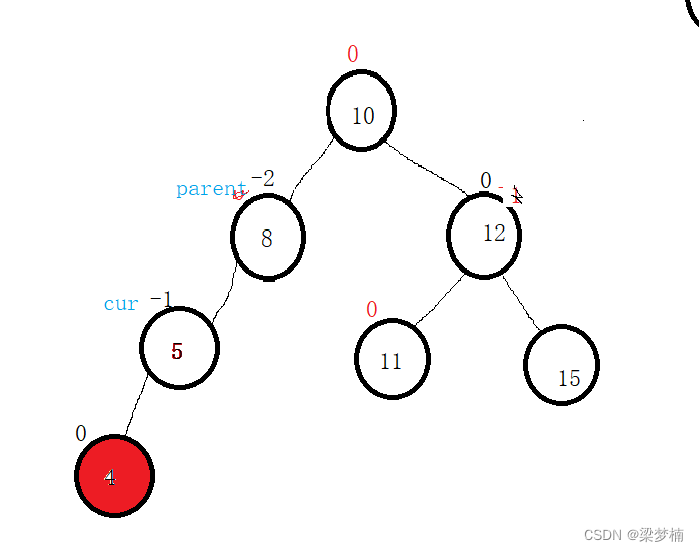
右旋的口诀:把cur的右边给parent的左边,cur的右边链接parent,在让parent的parent链接cur。会发现我们把原来的parent变成了cur的右边。并且现在是平衡的。
其实为什么要把cur的右边给parent呢?是因为cur的右边时当前树最大的值,cur给了parent链接到左边,依然不会破坏二叉搜索树的规则。

void RotateR(Node* parent )
{Node* subL = parent->_left;Node* subLR = subL->_right;parent->_left = subLR;if (subLR)subLR->_parent = parent;subL->_right = parent;Node* ppNode = parent->_parent;parent->_parent = subL;if (parent == _root){_root = subL;subL->_parent = nullptr;}else{if (ppNode->_left == parent){ppNode->_left = subL;}else{ppNode->_right = subL;}subL->_parent = ppNode;}parent->_bf = subL->_bf = 0;
}
右边高,左旋
当我们插入红色节点的时候就会导致右边过高,那么我们就需要左旋。
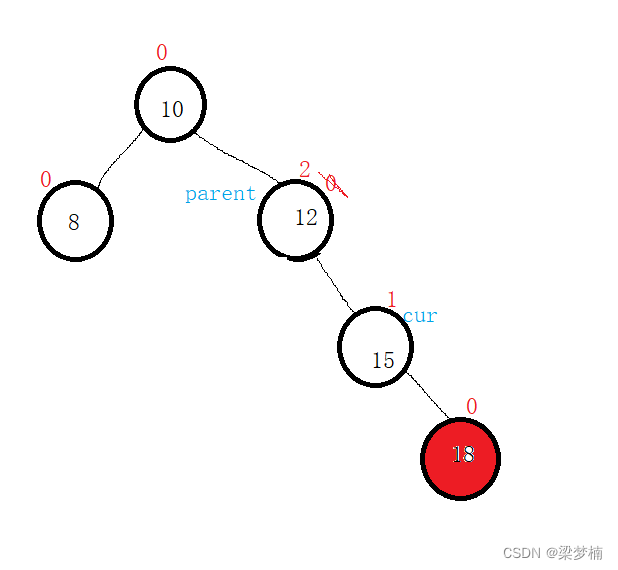
左旋的口诀:让cur的左边给parent的右边链接,然后让父亲变成cur的左边。
解释:为什么要把cur左边的值给parent的右边?cur当前位置是parent的右边,cur的左边也是比parent大的值,给parent的右边依然不影响二叉搜索树的规则。
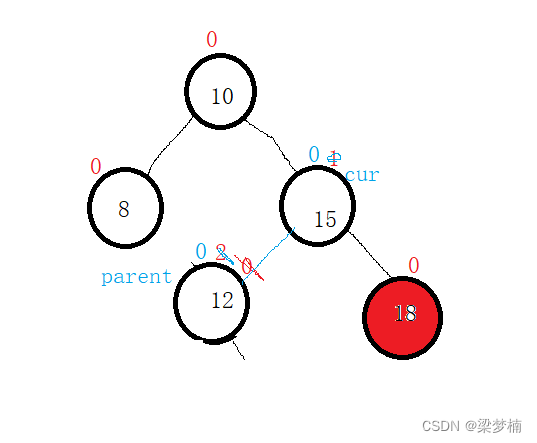
void RotateL(Node* parent)
{Node* subR = parent->_right;Node* subRL = subR->_left;parent->_right = subRL;if(subRL)subRL->_parent = parent;subR->_left = parent;Node* pphead = parent->_parent;parent->_parent = subR;if (parent == _root){_root = subR;subR->_parent = nullptr;}else{if (pphead->_parent == parent){pphead->_right = subR;}else{pphead->_left = subR;}subR->_parent = pphead;}subR->_bf = parent->_bf = 0;
}
双旋转
还有一种情况,它并不是单纯的一边高,用单旋并不能解决问题。当我们仅仅只是单旋会发现他有变成了形态不同,但是问题一样的情况,这个时候就需要双旋。
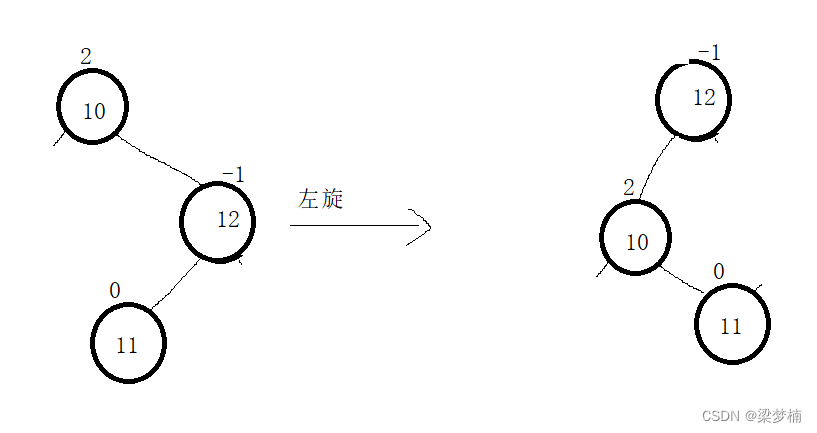
右左旋转:先右旋然后左旋。
既然我们单旋解决不了问题,我们可以把他变成一边高,然后进行单旋。
如这个图,我们可以对subR进行右旋后,在对parent左旋就可以了。
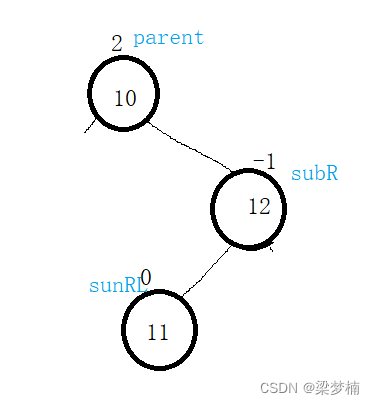
右左双旋后:

但是有个问题,平衡因子我们应该如何更新?你可能会说这种情况不是正好满足左旋/右旋后平衡因子变成0吗?但是如果其他位置都有节点呢?接下来我们抽象图,给大家演示一下。
当我们插入节点的位置不同,你会发现每一个平衡因子也不一样。如图:我插在了右边。这个时候我通过右左双旋就会得到下图。如最右图的红色平衡因子,应该变成这个情况。所以说插入的位置不同,平衡因子也会不同。
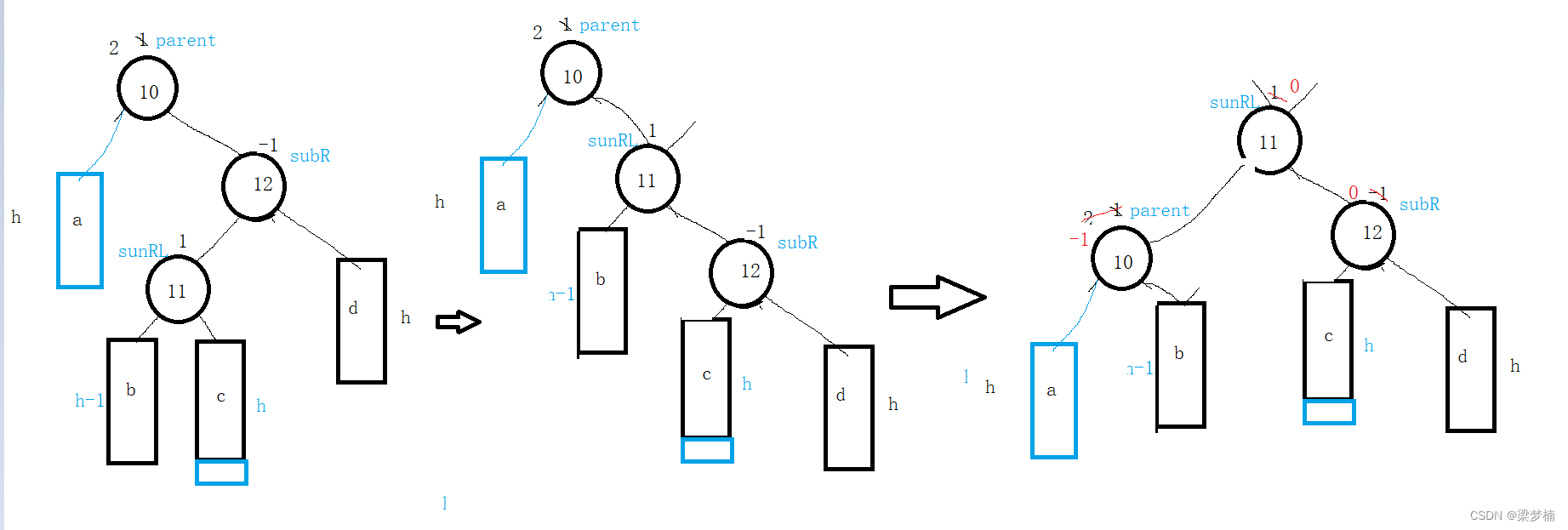
如图:假如我插在了左边。会发现平衡因子又不一样了。所以我们并不能用一个例子来概括所有。
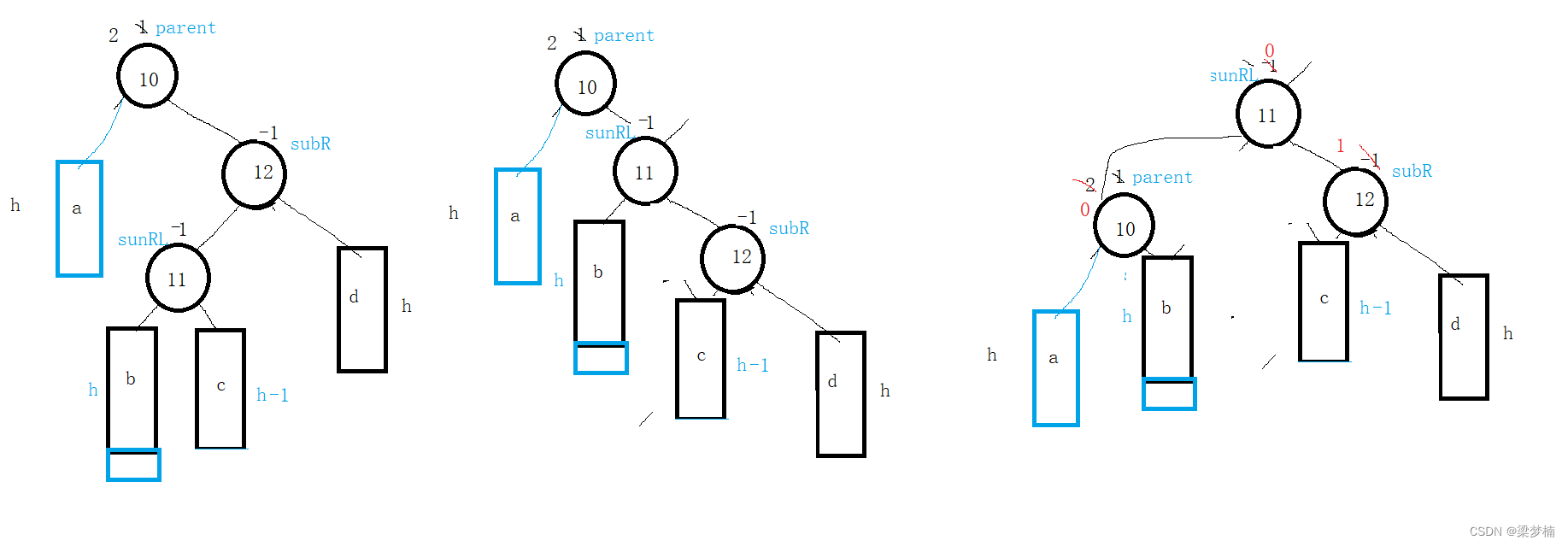
那么我们应该怎么做呢?其实从我们画图,你会发现我们改变的只不过是parent 、subR、sunRL这三个节点的因子,其他的并没有改变。并且,跟subRL的因子有密切关系,所以我们只需要判断subRL的因子是0/1/-1就能修改他们三个因子。
void RotateRL(Node* parent){//右左双旋//平衡因子需要自己调节Node* subR = parent->_right;Node* subRL = subR->_left;int bf = subRL->_bf;RotateR(subR);RotateL(parent);if (bf == 0){//新插入的parent->_bf =0;subR->_bf = 0;subRL->_bf = 0;}else if (bf == 1){//右边插入的subR->_bf = 0;subRL->_bf = 0;parent->_bf = -1;}else if(bf==-1){//在左边插入的parent->_bf = 0;subR->_bf = 1;subRL->_bf = 0;}else{assert(false);}}
左右双旋:先左旋,在右旋。
图下是:左右双旋。
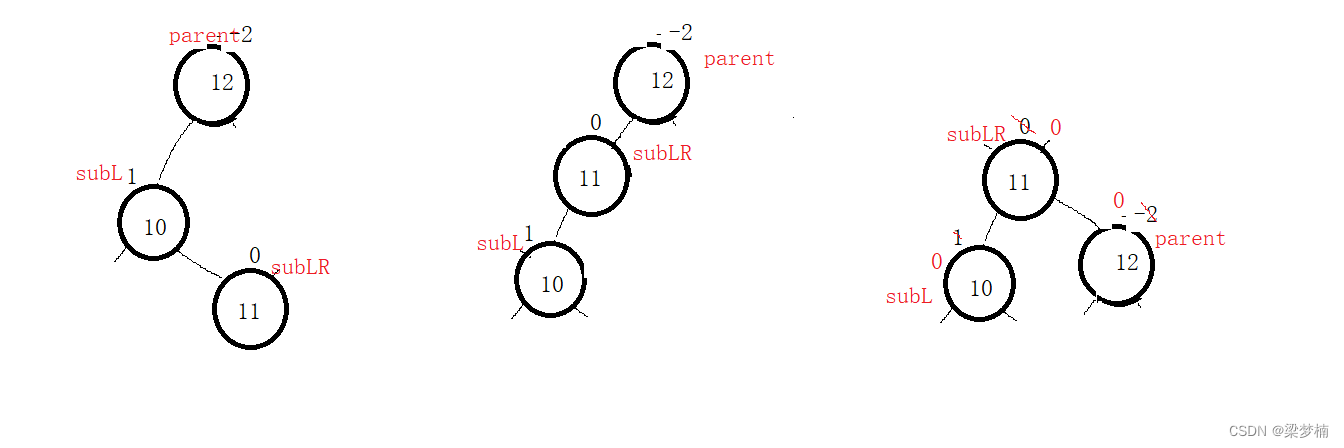
当然了,我们依然需要分析平衡因子,所以我们依然要分析插入在哪个位置。
如图:当插入在右边。

如图:当我们插在左边。

void RotateLR(Node* parent){//左右双旋//平衡因子需要单独调节Node* subL = parent->_left;Node* subLR = subL->_right;int bf = subLR->_bf;//先左旋在右旋RotateL(parent->_left);RotateR(parent);//重新计算调节因子if (bf == 0){//当且节点就是新插的subL->_bf = 0;parent->_bf = 0;subLR->_bf = 0;}else if(bf==1){//在当前节点的右边插入的parent->_bf = 0;subL->_bf = -1;subLR->_bf = 0;}else if(bf == -1){subL->_bf = 0;parent->_bf = 1;subLR->_bf = 0;}else{assert(false);}}
中序遍历
因为二叉搜索树我们都是中序遍历,因为中序遍历更接近有序。
void _Inorder(Node* root)
{if (root == nullptr){return;}_Inorder(root->_left);cout << root->_kv.first << ":" << root->_kv.second<<endl;_Inorder(root->_right);
}
判断是否平衡
什么时候不平衡?是不是因子大于等于2的时候,所以我们需要算左右树的高度相减,如果超过2,那就是不平衡。
bool _isBalance(Node* root){if (root == nullptr){return true;}int left = _Height(root->_left);int right = _Height(root->_right);if (abs(left - right) >= 2) return false;//因子大于等于2的时候不平衡return _isBalance(root->_left) && _isBalance(root->_right);}int _Height(Node* root){if (root == nullptr)return 0;int left = _Height(root->_left);int right = _Height(root->_right);return max(left, right) + 1;}
AVL树整体代码
以下是整个AVL树所有的代码?
问题:为什么没有像库一样写删除呢?答:我们模拟实现其实是为了了解底层,并不是要超过底层,因为现有的库已经很好了,我们没必要写一个。二叉搜索树很少用删除接口。所以这里没有实现。
#pragma once
#include<iostream>
#include<vector>
#include<string>
#include<assert.h>using namespace std;
namespace KV
{template<class K,class V>struct AVLTreeNode{AVLTreeNode(const pair<K, V> kv):_left(nullptr),_right(nullptr),_parent(nullptr),_kv(kv),_bf(0){}AVLTreeNode* _left;AVLTreeNode* _right;AVLTreeNode* _parent;pair<K, V> _kv;int _bf;};template<class K,class V>class AVLTree{public:typedef AVLTreeNode<K,V> Node;bool insert(const pair<K, V> kv){if (_root == nullptr){//插入第一个值Node* newNode = new Node(kv);_root = newNode;return true;}Node* newNode = new Node(kv);Node* cur = _root;Node* parent = cur;while (cur){if (cur->_kv.first < newNode->_kv.first){//大于在右边parent = cur;cur = cur->_right;}else if (cur->_kv.first > newNode->_kv.first){//小于在左边parent = cur;cur = cur->_left;}else{//等于,二叉搜索树不允许冗余,所以直接返回false。return false;}}if (parent->_kv.first > newNode->_kv.first){//在左边parent->_left = newNode;}else{//在右边parent->_right = newNode;}newNode->_parent = parent;cur = newNode;while (parent){if (parent->_left == cur){cur->_parent->_bf--;}else if (parent->_right == cur){cur->_parent->_bf++;}if (parent->_bf == 0){break;}else if (parent->_bf == 1 || parent->_bf == -1){cur = parent;parent = parent->_parent;}else if (parent->_bf == 2 || parent->_bf == -2){//出现健康问题需要旋转//左边高,右旋转if (parent->_bf == -2 && cur->_bf == -1){RotateR(parent);}//右边高,左旋转else if (parent->_bf == 2 && cur->_bf == 1){RotateL(parent);}else if (parent->_bf == -2 && cur->_bf == 1){//左右双旋RotateLR(parent);}else if (parent->_bf == 2 && cur->_bf == -1){//右左双旋RotateRL(parent);}else{assert(false);}}else{//按道理说不可能有这种情况,但是保不准会有bugassert(false);break;}}return true;}void Inorder(){_Inorder(_root);}int Height(){return _Height(_root);}bool isBalance(){return _isBalance(_root);}private:int _Height(Node* root){if (root == nullptr)return 0;int left = _Height(root->_left);int right = _Height(root->_right);return max(left, right) + 1;}bool _isBalance(Node* root){if (root == nullptr){return true;}int left = _Height(root->_left);int right = _Height(root->_right);if (abs(left - right) >= 2) return false;return _isBalance(root->_left) && _isBalance(root->_right);}void RotateRL(Node* parent){//右左双旋//平衡因子需要自己调节Node* subR = parent->_right;Node* subRL = subR->_left;int bf = subRL->_bf;RotateR(subR);RotateL(parent);if (bf == 0){//新插入的parent->_bf =0;subR->_bf = 0;subRL->_bf = 0;}else if (bf == 1){//右边插入的subR->_bf = 0;subRL->_bf = 0;parent->_bf = -1;}else if(bf==-1){//在左边插入的parent->_bf = 0;subR->_bf = 1;subRL->_bf = 0;}else{assert(false);}}void RotateLR(Node* parent){//左右双旋//平衡因子需要单独调节Node* subL = parent->_left;Node* subLR = subL->_right;int bf = subLR->_bf;//先左旋在右旋RotateL(parent->_left);RotateR(parent);//重新计算调节因子if (bf == 0){//当且节点就是新插的subL->_bf = 0;parent->_bf = 0;subLR->_bf = 0;}else if(bf==1){//在当前节点的右边插入的parent->_bf = 0;subL->_bf = -1;subLR->_bf = 0;}else if(bf == -1){subL->_bf = 0;parent->_bf = 1;subLR->_bf = 0;}else{assert(false);}}void RotateR(Node* parent ){Node* subL = parent->_left;Node* subLR = subL->_right;parent->_left = subLR;if (subLR)subLR->_parent = parent;subL->_right = parent;Node* ppNode = parent->_parent;parent->_parent = subL;if (parent == _root){_root = subL;subL->_parent = nullptr;}else{if (ppNode->_left == parent){ppNode->_left = subL;}else{ppNode->_right = subL;}subL->_parent = ppNode;}parent->_bf = subL->_bf = 0;}void RotateL(Node* parent){Node* subR = parent->_right;Node* subRL = subR->_left;parent->_right = subRL;if(subRL)subRL->_parent = parent;subR->_left = parent;Node* pphead = parent->_parent;parent->_parent = subR;if (parent == _root){_root = subR;subR->_parent = nullptr;}else{if (pphead->_parent == parent){pphead->_right = subR;}else{pphead->_left = subR;}subR->_parent = pphead;}subR->_bf = parent->_bf = 0;}void _Inorder(Node* root){if (root == nullptr){return;}_Inorder(root->_left);cout << root->_kv.first << ":" << root->_kv.second<<" 因子:" <<root->_bf<< endl;_Inorder(root->_right);}Node* _root=nullptr;};
}











)






-RNN 的常见模型架构)